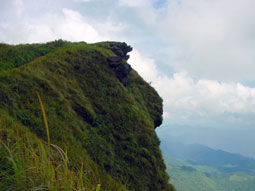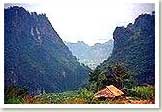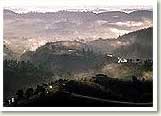Road to Chiang Rai
I like to get out of Bangkok when I can. I find the noise, pollution, traffic and scale of Bangkok a little wearisome. Recently I took a road trip to the Chiang Rai region in the very north of the country. It was was a lot of fun, very relaxing and we collected some great pictures.
To see more pictures of the trip, please go to: http://blog.artthailand.net/gallery/index.php?level=album&id=10
Many people outside Thailand assume that if you have been to Bangkok you have been to Thailand. In fact, Krung Thep (roughly translating to City of Angels), to use it’s Thai name, has been the capital of Thailand, or Siam, only since the very end of the 18th century, succeeding Ayuthaya and Sukothai.
Bangkok (translating as ‘village of wild plums’) was the original site for the capital city and was located west of the Chao Phraya river (in modern day Thonburi).
In 1782, King Rama I decided to move to a more defensible site and moved across the river to found his new capital, Krung Thep. For whatever reason, foreigners have never since caught up with the name change and the old name of Bangkok has stuck. In recent years, Krung Thep/Bangkok has expanded at such a fast rate that it now sprawls over a huge mass of land on both the sides of the Chao Phraya and has engulfed the once independent Thonburi.
Krung Thep is actually an abbreviated version of the ceremonial full name, which is shown below in a romanized form.
Krung Thep Mahanakhon Amon Rattanakosin Mahinthara Ayuthaya Mahadilok Phop Noppharat Ratchathani Burirom Udomratchaniwet Mahasathan Amon Piman Awatan Sathit Sakkathattiya Witsanukam Prasit
In English this translates, roughly, to: The city of angels, the great city, the residence of the Emerald Buddha, the impregnable city (of Ayutthaya) of God Indra, the grand capital of the world endowed with nine precious gems, the happy city, abounding in an enormous Royal Palace that resembles the heavenly abode where reigns the reincarnated god, a city given by Indra and built by Vishnukarn.
Perhaps we should stick to Bangkok!
Early August we set off to Chiang Mai from Bangkok. The trip is for business, to attend a gallery opening in Chiang Rai. It’s easier to fly but I drive whenever I can. We decided to drive straight to Chiang Mai, break for the night, then move on to Chiang Rai the next day. It takes about seven hours to get to Chiang Mai, depending on traffic, the lunatic Formula 1 aspirations of your driver, and taking the right roads. Addisorn certainly has Formula 1 aspirations, and the only traffic problem we had was running into a funeral, but he can’t read a map, so we arrived late.
It’s a pleasant though unremarkable route, mostly by expressway. One joy is to see the rice fields. Field upon field stretching endlessly both vertically and horizontally. Rice farmers and their families working the fields. You feel as if you are going back in time to a more peaceful and simple existence, out from the city into the farming heartland of Thailand.
Last year I took the same route with my children but we spent four days getting to Chiang Mai, stopping off at Ayuthaya, Lopburi, Sukothai, Lampang and Phitsanulok to see a variety of sights.
In Europe I would never describe myself as a church freak. I am happy to visit the odd cathedral here and there but that’s about it. In Thailand I definitely fall into the category of temple addict. I love the Buddhist culture and the temples, whether extant or in ruins, induce all sorts of strange emotions in me.
Of all the places we visited Ayuthaya is the best known, being close to Bangkok, but Sukothai was for me the most interesting experience. Finding good hotels proved challenging. We stayed in some fairly weird places but I am now beginning to get to grips with the concept of Thai travel lodges. Luxurious they are not but they are clean, often set in very beautiful countryside and they do more for me than the functionalism of a convention type hotel.
This time we got close to Chiang Mai at around six and stopped off for dinner in a small town, beside the market. The markets are the soul of Thai rural society.You eat there, you shop there and you see Thailand there. Exotic smells, wonderfully fresh food, often grown by small families selling off their surplus.
In the outer edges of the bigger cities there are very few non-Thai and I always find myself being observed by young and old alike, as if I am an alien from another planet. I try to speak Thai to them , asking perhaps for some noodle soup or some geng daeng (red curry) and they respond with vacant stares which demonstrate that knowing Thai vocabulary is not even close to being able to speak the language!
As almost everywhere in Thailand the people are unfailingly polite and charming. Eventually we find food I can eat and then I observe the food sellers watching me to see if I can cope with the spice! There are chuckles of delight as I cough violently on som tam and expressions of satisfaction as I ask for more.
We get into Chiang Mai itself around eight. Part of our mission is to find some high quality boutique hotels to recommend to future clients.
It’s a nice idea in principle but it can be hell finding these places. We are staying at a place called Baan Singh Kham and we are lost. We call the hotel and the manager tells us to hold on and he will come and find us. After a few minutes he arrives and we follow him to the hotel.
It’s dark so it’s difficult to assess the hotel properly but the rooms, while eccentric, are fantastic, and we are paying just 2,000 baht for the night. You can see more information about the hotel at http://www.hotelthailand.com/chiangmai/baansinghkham/index.html
The site is not great but don’t let that put you off. The hotel is charming, small (I like small), very clean and very beautiful. Take a look at the bathrooms on the site! They are just a lot of fun.
I highly recommend this place. The staff are efficient, polite and they speak good English too. Ok, the place is a little eccentric. The fitness room is a bike on a balcony. New York this ain’t! You know, if I wanted New York I would go to New York. This is Thailand and I am content.
We go into Chiang Mai for dinner and find a pretty good Thai restaurant. We then wander off into the nightlife. It’s not the same as Bangkok. Yes, there are beer bars and gogo bars and a mass of karaoke bars but it is very laid back. In fact it is fair to say that Chiang Mai is generally a laid back city with its own, very unique charm. The three of us play a little pool, drink a little beer and eventually wander by accident into what is termed a gogo.
I am the only farang. No one speaks a word of English and who ever heard of a gogo bar with no poles? Well, there is a pole but it is at the entrance to the bar rather than in the bar itself. We are “entertained” by girls spitting darts to burst balloons, opening bottles of beer and doing various other weird and wonderful things with (how can I put this subtly) various and unlikely body parts.
Next morning I wake early, read in a chair on the balcony and gently watch the world pass me by. We all have breakfast and then set off for Chiang Rai. It’s not far, a little over a 100km but it’s through some very hilly terrain with slow, single lane tracks. Yet this is Thailand maybe at it’s best — green and lush, sun reflecting off the rice fields, the air fresh and clean.
Our destination is uncertain, meaning we have no idea where it is! It’s a new hotel called Doi Hom Fha. All we really know is that it is accessible by track rather than by road and that we have to take a ferry to reach the hotel itself.
Via many conversations on the phone we do eventually find the track, though “track” is a poor description. It’s more a mud trail to nowhere.
Eventually we pass through a small village of open huts and see the horizon of what appears to be a huge lake. We see boys playing in the water, fishing with small sticks. There are men in small, lazy boats fishing in the open water, also amidst the foliage of the shores. The sun lights up a panorama and we are in another world. It’s magnificent, isolated, huge and inspiring.

The hotel itself is hard to describe. It’s better experienced via pictures. The lobby is like a giant cave. I have never seen anything so big in my life. I sense there should be bats lining the walls and ceiling. The manager is hospitality herself except I mean himself as “she” later turned out to be a “he’, wonderfully eccentric, exaggeratedly feminine but fun to know. I could have done without the details of the upcoming “final” operation however.
The rooms are small villas and it’s clear we are occupying the only functional ones, functional being a relative term. The hotel is not properly open for business as yet. The grand opening is in January 2007. This is clearly meant to a 5-star resort and it is, but in a Thai way. So the advertised DVD player is found in one room but not in mine. The aircon works but vaguely so. The tap comes off my shower and the wiring looks more dangerous than an unexploded cluster bomb! And outside showers and baths are a wonderful concept except when it is raining!
Yet it really doesn’t matter. Everyone is friendly and you sense they probably will get everything fixed by January and the place is just so wonderful that I can manage almost any problem. Aso, we are paying 2,500 baht versus a rack rate of 8,000.
The site address is http://www.doihomfharesort.com/index.html. It is worth taking a look.
We are driven around the resort. It’s owned by a Thai who made his fortune in jewelry. You sense this is his fantasy project. Honestly I don’t see how the economics can work but feel the love that has gone into the project. The basis of everything is wine. The vineyards were laid down about 10 years ago with shiraz grapes. There is an enormous, I would almost say fantastic, winery with great vats full of wine.
Next we move onto the jewelry factory where gemstones are being polished by about thirty workers. Beside is the tea house where we sample about 10 different types of tea. All around is the most wonderful scenery you will ever see. What a place this is. If I was staying in a tent I would be happy here and I never do tents! If you want to escape into a civilized wilderness, far from anyone, privacy guaranteed, set in the most beautiful surrounds, then this is the place for you. All of us fall in love with the place. All of us will return.
Later we go into Chiang Rai itself for the gallery opening. On our return we discover that the ferryman has fallen asleep on the wrong side of the lake! Our driver is getting increasingly frantic trying to raise him on the radio. I am beginning to think about the merits of 4 of us sleeping in one car. He does eventually wake up and we cross in the darkness, the lake holding its secrets from us like an eclipse of the moon.

My previous time in Chiang Rai I had stayed right beside the Mekong River. We took a boat into the Golden Triangle passing huge Buddhas as we criss-crossed Thailand, Laos and Burma. We also visited the Queen Mother’s Summer Palace where there is a feast of flowers that overwhelms the senses.

I also had the misfortune to be conned by my children into an elephant ride across the river. This was not cool. Uncomfortable, often scary, am I the only person who suffers from elephant motion sickness? The Mekong and the areas around the Mekong are the equal of Doi Hom Fha, but much more geared to the tourist. I can only say that I adore the whole of the Chiang Rai region. It’s my favorite part of Thailand. I would happily get lost there for weeks on end.
The next day, Sunday, we drove home to Bangkok. It’s a 10-12 hour drive. Addisorn managed to lose us a few times, to the point that we started to believe we might end up in Hat Yai if we didn’t stay awake to guide him! Oh for the joys of satellite navigation. In Europe I can almost close my eyes on a 500km trip from Geneva to the Arc de Triomphe in Paris. In Thailand I can get lost going round a corner.

Three days is not nearly enough time to do this trip. We saw almost nothing, yet we also saw everything. I would recommend taking 5-6 days, driving slowly, stopping often, keeping away from the main metropolises, with the exceptions of Chiang Mai and Chiang Rai. It’s a wonderful experience and a fun and novel way to experience more of what Thailand is about.

Last, some links for you about Chiang Rai:
http://www.chiangraiprovince.com/guide/
http://www.chiangmai-chiangrai.com/
http://www.hotelclub.net/hotel.reservations/Chiang_Rai.htm
http://www.thaiwaysmagazine.com/chiang_rai_map/chiang_rai_map.html
http://www.world66.com/asia/southeastasia/thailand/chiangrai
……….We Put The World Of Contemporary Art From Thailand Within Reach

 From Chiangrai City, you can reach any of the following frontier spots within one or two hours. Chiang Khong is due east of Chiangrai. A small fishing and farming town on the Mae Khong River border with Laos, in addition to the very quaint Southeast Asian flavor you get in this town, you'll get a clear view of the town's sister village across the river. Chiang Khong carries on a brisk trade with its counterpart in Laos. Unfortunately, non-Thais can't cross into Laos at this point, but you can go for a riverboat ride and get pretty close.
From Chiangrai City, you can reach any of the following frontier spots within one or two hours. Chiang Khong is due east of Chiangrai. A small fishing and farming town on the Mae Khong River border with Laos, in addition to the very quaint Southeast Asian flavor you get in this town, you'll get a clear view of the town's sister village across the river. Chiang Khong carries on a brisk trade with its counterpart in Laos. Unfortunately, non-Thais can't cross into Laos at this point, but you can go for a riverboat ride and get pretty close.  Designed by Robert Trent Jones Jr., this course features a wide range of sloping lies and natural hazards. Surrounded by distant hills, the golf course and housing development is set on low hilly land. At holes 2,3 & 4 players have to play alongside a huge lake. Most greens are well protected by bunkers and there are several very good dog-leg holes, particularly the par-5 eighteenth, where players have to negotiate water on the right side of the fairway on the approach shot to the green. The clubhouse is very agreeable and hotel accommodations are on site.
Designed by Robert Trent Jones Jr., this course features a wide range of sloping lies and natural hazards. Surrounded by distant hills, the golf course and housing development is set on low hilly land. At holes 2,3 & 4 players have to play alongside a huge lake. Most greens are well protected by bunkers and there are several very good dog-leg holes, particularly the par-5 eighteenth, where players have to negotiate water on the right side of the fairway on the approach shot to the green. The clubhouse is very agreeable and hotel accommodations are on site.




 This northernmost Thai mountain contains sveral scenic spots, including the Doi Tung Royal Villa, the Mae Fah Luang Botanical Garden, the mountaintop Wat Phrathat Doi Tung which affords a spectacular view of the surrounding area, and contains Buddha relics,and various hilltribe villages in natural settings.
This northernmost Thai mountain contains sveral scenic spots, including the Doi Tung Royal Villa, the Mae Fah Luang Botanical Garden, the mountaintop Wat Phrathat Doi Tung which affords a spectacular view of the surrounding area, and contains Buddha relics,and various hilltribe villages in natural settings. 



 This monument is situated at the starting point of the road to Mae Chan, Chiang Saen and Mae Sai.
This monument is situated at the starting point of the road to Mae Chan, Chiang Saen and Mae Sai. Situated behind Wat Phrasing, is believed to have been the original residence of the Emerald Buddha which is now in Bangkok at the Royal Temple of the same name.
Situated behind Wat Phrasing, is believed to have been the original residence of the Emerald Buddha which is now in Bangkok at the Royal Temple of the same name.





